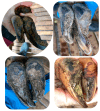Lameness and Hoof Disorders in Sheep and Goats from Small Ruminant Farms in Selangor, Malaysia
- PMID: 40646757
- PMCID: PMC12248598
- DOI: 10.3390/ani15131858
Lameness and Hoof Disorders in Sheep and Goats from Small Ruminant Farms in Selangor, Malaysia
Abstract
Hoof disorders in small ruminants pose significant challenges to animal welfare and farm productivity. This study presents the first attempt to determine the prevalence of lameness and hoof disorders and their associated risk factors in goat and sheep farms in Selangor, Malaysia. Locomotion scores were collected from 226 animals (126 sheep and 100 goats) across 10 farms. A hoof examination was conducted, and hoof lesions were identified through detailed photographic evaluation. On-farm assessments and interviews were conducted to gather information on management practices from the farms. Data were analysed using descriptive statistics, bivariate analysis, and logistic regression models. The prevalence of lameness was 42.8% (95% CI 34.2 to 51.9) in sheep and 23.0% (95% CI 16.3-38.4) in goats. Significant variation (p > 0.05) in lameness prevalence was observed across farms, ranging from 26.7% to 61.5% in sheep and 7.7% to 30.8% in goat farms. The majority of lameness and hoof lesions were observed in the hindlimbs of both species. The prevalence of hoof disorders was 91.3% (95% CI 84.6-95.4) in sheep and 43.0% in goats (95% CI 21.4-58.0). The predominant hoof disorders were overgrown wall horn, white line disease, sole bruise, and wall fissures. No hoof affections of infectious origin were observed in the sampled animals. Risk factors for lameness and hoof lesions in sheep included pregnancy, semi-intensive management, and breeds other than Damara. Higher odds of lameness were observed in exotic goat breeds and those with overgrown wall horns. In conclusion, this study revealed a high prevalence of lameness and hoof disorders in goat and sheep farms, highlighting the need to address these important welfare and economic issues. While the identified risk factors could be considered for the management of hoof disorders in small ruminant farms, a larger sample size that is representative of the sheep and goat population is recommended for more generalizable results.
Keywords: animal welfare; hoof disorders; lameness; risk factors; small ruminants.
Conflict of interest statement
The authors declare no conflicts of interest.
Figures


Similar articles
-
Seroepidemiological study of Chlamydia abortus in domestic and wild ruminants in Spanish Mediterranean ecosystems.Prev Vet Med. 2025 Oct;243:106600. doi: 10.1016/j.prevetmed.2025.106600. Epub 2025 Jun 20. Prev Vet Med. 2025. PMID: 40554956
-
Management practices and herd-level risk factors associated with bovine lameness in Egyptian dairy herds.Trop Anim Health Prod. 2025 Aug 6;57(7):352. doi: 10.1007/s11250-025-04593-3. Trop Anim Health Prod. 2025. PMID: 40768010
-
Seroprevalence and risk factors for sheep pox and goat pox among small ruminant herds from Nakapiripirit and Sembabule districts, Uganda.Front Vet Sci. 2025 Jul 25;12:1579164. doi: 10.3389/fvets.2025.1579164. eCollection 2025. Front Vet Sci. 2025. PMID: 40786978 Free PMC article.
-
Signs and symptoms to determine if a patient presenting in primary care or hospital outpatient settings has COVID-19.Cochrane Database Syst Rev. 2022 May 20;5(5):CD013665. doi: 10.1002/14651858.CD013665.pub3. Cochrane Database Syst Rev. 2022. PMID: 35593186 Free PMC article.
-
Home treatment for mental health problems: a systematic review.Health Technol Assess. 2001;5(15):1-139. doi: 10.3310/hta5150. Health Technol Assess. 2001. PMID: 11532236
References
-
- Kaler J., Medley G.F., Grogono-Thomas R., Wellington E.M.H., Calvo-Bado L.A., Wassink G.J., King E.M., Moore L.J., Russell C., Green L.E. Factors associated with changes of state of foot conformation and lameness in a flock of sheep. Prev. Vet. Med. 2010;97:237–244. doi: 10.1016/j.prevetmed.2010.09.019. - DOI - PubMed
-
- Ibishi L., Musliu A., Mehmedi B., Rexhepi A., Youngs C.R., Behluli B. Economic losses due to clinical lameness in Kosovo dairy cattle. Vet. Stanica. 2021;53:295–304. doi: 10.46419/vs.53.3.4. - DOI
LinkOut - more resources
Full Text Sources

